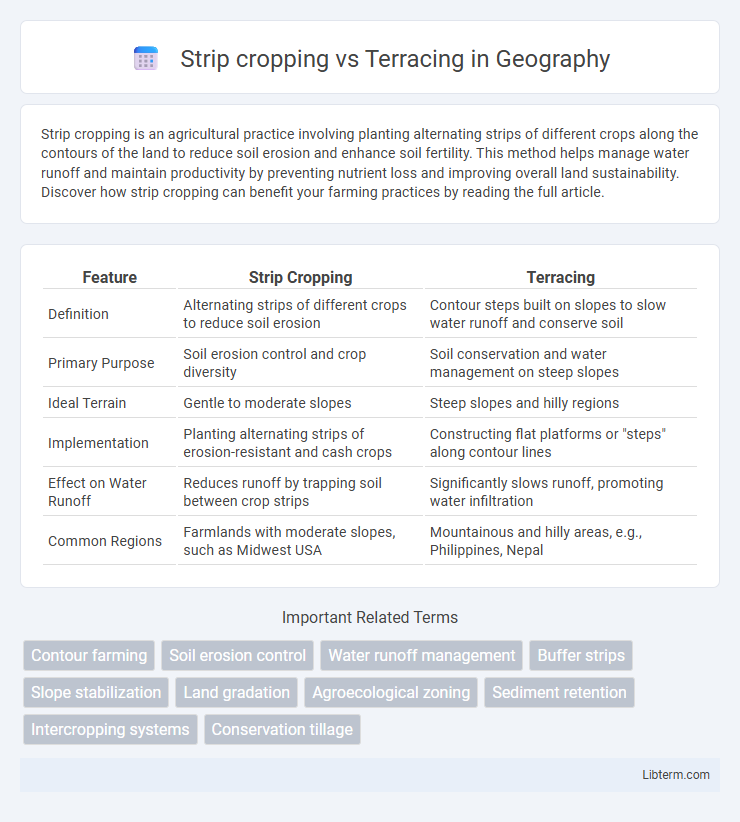Strip cropping is an agricultural practice involving planting alternating strips of different crops along the contours of the land to reduce soil erosion and enhance soil fertility. This method helps manage water runoff and maintain productivity by preventing nutrient loss and improving overall land sustainability. Discover how strip cropping can benefit your farming practices by reading the full article.
Table of Comparison
| Feature | Strip Cropping | Terracing |
|---|---|---|
| Definition | Alternating strips of different crops to reduce soil erosion | Contour steps built on slopes to slow water runoff and conserve soil |
| Primary Purpose | Soil erosion control and crop diversity | Soil conservation and water management on steep slopes |
| Ideal Terrain | Gentle to moderate slopes | Steep slopes and hilly regions |
| Implementation | Planting alternating strips of erosion-resistant and cash crops | Constructing flat platforms or "steps" along contour lines |
| Effect on Water Runoff | Reduces runoff by trapping soil between crop strips | Significantly slows runoff, promoting water infiltration |
| Common Regions | Farmlands with moderate slopes, such as Midwest USA | Mountainous and hilly areas, e.g., Philippines, Nepal |
Introduction to Strip Cropping and Terracing
Strip cropping involves alternating strips of different crops along the contour of the land to reduce soil erosion and enhance moisture retention, making it effective on moderately sloped fields. Terracing transforms steep slopes into a series of flat, step-like platforms, significantly minimizing runoff and soil loss while allowing farming in otherwise challenging hilly terrains. Both techniques are vital soil conservation practices, with strip cropping suited for gentle slopes and terracing designed for steep landscapes.
Definition and Key Concepts
Strip cropping involves alternating strips of different crops planted across a slope to reduce soil erosion and improve soil fertility by disrupting water flow and wind patterns. Terracing consists of creating level stepped areas on steep terrain to slow water runoff, prevent soil erosion, and maximize arable land for cultivation. Both methods are essential soil conservation techniques tailored to specific landscape conditions for sustainable agriculture.
Historical Development of Both Practices
Strip cropping originated in the early 19th century as a soil conservation method to reduce runoff and erosion by alternating strips of row crops with strips of grass or cover crops. Terracing dates back to ancient civilizations such as the Inca and Chinese, where it was developed to transform steep slopes into arable land, effectively controlling water flow and preventing soil erosion. Both practices evolved through centuries of empirical use, adapting to regional agricultural needs and advancing with modern engineering techniques to enhance sustainable farming.
How Strip Cropping Works
Strip cropping works by alternating strips of different crops along the contour of the land, reducing soil erosion and runoff by creating natural barriers. This method slows water flow and enhances water infiltration, improving soil moisture retention and reducing nutrient loss. Unlike terracing, which reshapes the land into stepped levels, strip cropping maintains the natural slope while protecting the soil through crop diversity and strategic planting patterns.
How Terracing Works
Terracing involves creating stepped levels on steep terrain to reduce soil erosion and surface runoff by slowing water flow and allowing it to infiltrate the soil more effectively. This practice enhances water retention and reduces nutrient loss, making it ideal for hilly or mountainous agricultural areas. Unlike strip cropping, which alternates strips of different crops to control erosion on flatter land, terracing physically reshapes the landscape to maintain soil stability on slopes.
Environmental Benefits of Strip Cropping
Strip cropping reduces soil erosion by alternating strips of different crops, which enhances water infiltration and minimizes runoff. It promotes biodiversity by creating varied habitats and supports soil health through nutrient cycling. This method effectively protects farmland on gentle slopes, preventing nutrient loss and improving overall ecosystem resilience.
Environmental Benefits of Terracing
Terracing significantly reduces soil erosion by creating level steps on steep slopes, which slows water runoff and increases water infiltration. This method enhances soil fertility and prevents nutrient loss, promoting sustainable agriculture in hilly or mountainous regions. Terracing also aids in flood control by effectively managing rainwater flow, thereby protecting downstream ecosystems and farmlands.
Comparative Analysis: Effectiveness and Limitations
Strip cropping and terracing both serve as soil conservation techniques, with strip cropping particularly effective in reducing soil erosion on gently sloping lands by alternating crop strips and fallow land. Terracing, designed primarily for steep slopes, significantly decreases runoff velocity and soil loss by creating leveled steps, but involves higher labor and construction costs. While strip cropping offers flexibility in crop rotation and lower initial investment, terracing provides long-term stability and increased arable land on otherwise unusable slopes, though it may require ongoing maintenance to prevent degradation.
Economic Considerations and Implementation Costs
Strip cropping typically involves lower initial implementation costs compared to terracing, making it more accessible for small-scale farmers seeking quick erosion control. Terracing requires significant labor and investment in construction and maintenance, but it can lead to higher long-term economic benefits through improved land productivity and reduced soil loss. Choosing between strip cropping and terracing depends on factors such as farm size, topography, available capital, and expected return on investment.
Choosing the Right Method for Your Land
Strip cropping is ideal for gently sloping land where alternating strips of crops reduce soil erosion by slowing water runoff, while terracing is better suited for steep slopes, creating flat platforms that minimize erosion and conserve water. Evaluating soil type, slope gradient, and local climate ensures selecting the method that maximizes soil retention and crop yield. Implementing the right erosion control technique enhances sustainable land management and long-term agricultural productivity.
Strip cropping Infographic

 libterm.com
libterm.com